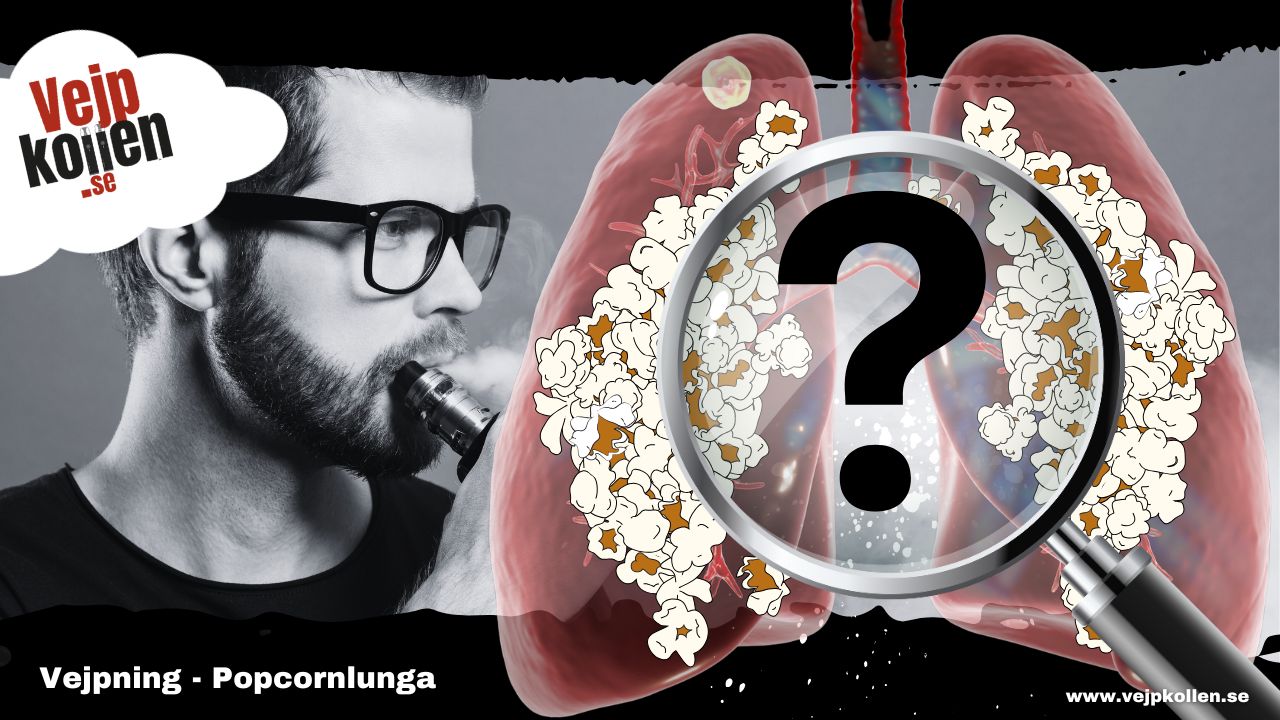A very common question/comment on Vejpkollen's social media is the one about vejpning and popcorn lung. Popcorn lung is another name for the lung disease bronchiolitis obliterans.
The disease causes scarring of the lungs and can be linked, among other things, to inhalation of the chemical diacetyl. The disease leads to chronic breathing difficulties, similar in many respects to COPD.
But what does this have to do with e-cigarettes and why has the myth that vejp users are at risk of popcorn lung stuck in the debate?
– This is an article created to explain and broaden the discussion about a claim that often appears on Vejkollen's social media. Do you have more questions? Don't hesitate to ask them to the editors! –
Popcorn lung. The image of a lung filled with popcorn is both comical and scary. It's an image that is widely used on social media - not least to attract attention and spread a message about e-cigarettes and vejpning. However, the information disseminated is often downright misleading. Popcorn lung (or the disease bronchiolitis obliterans) has never been linked to any cases involving vejpning and the likelihood of it ever happening is virtually non-existent. But that doesn't stop the myth of popcorn lung from persisting. It is simply too "good an image" NOT to be included in campaigns to discourage the use of e-cigarettes. And unfortunately, this has led to gross misconceptions about the health risks associated with vejping.
But what is it all about?
First and foremost. What is bronchiolitis obliterans (aka. popcorn lung)?
This is how the disease is generally described (according to Wikipedia):
"Bronchiolitis obliterans is an uncommon disease in the general population. However, it affects about 75 per cent of people within 10 years of a lung transplant and up to 10 % of those who have received a bone marrow transplant from another person. The disease was first clearly described in 1981, but there are reports of similar cases dating back to 1956. The term itself bronchiolitis obliterans was first used by the doctor Reynaud in 1835.
Symptom:
The condition leads to a gradual deterioration in breathing, wheezing and a dry cough. Symptoms may develop slowly, but in some cases they can be sudden and severe. This disease affects the lungs in a way that makes it difficult to breathe and cannot be relieved by standard bronchodilator medicines. This can be due to a number of factors, including
- Autoimmune diseases (where the body's immune system attacks its own lungs)
- Injuries from inhalation of harmful substances
- Immune response after a transplant
- Consequences of an infection
- Reaction to certain medicines
What does this mean for vejpare?
No vejpare has to date diagnosed with "bronchiolitis obliterans". But of course, vejpa means that you are breathing in chemicals in greater quantities than if you just breathe in clean air. And although cigarette smoke also contains chemicals (nearly 7000) and vejpa vapour contains far fewer (nearly 100), this fact has led many people to assume that vejpa is essentially as harmful as smoking. Many even think "worse" as they consider the smoke from tobacco to be "natural" and the vapour from e-liquid to be "unnatural".
Popcorn lung and diacetyl
In the specific case of popcorn lung, this is highly relevant. Bronchiolitis obliterans was found in 2000 in a number of cases where workers in a microwave popcorn factory inhaled large amounts of the substance over a long period of time diacetyl, a chemical with a butter-like flavour that was used in its production. This was the first time diacetyl was linked to bronchiolitis obliterans. It was also here that the name "popcorn lung" was coined.
Almost 10 years later, vejpare noticed that even some e-liquids contained small amounts of diacetyl. The aim was to get manufacturers, which were few at the time, to stop using diacetyl to make certain e-juices (containing various creamy flavours - milkshakes, pastries, custards). Not surprisingly, this attracted media attention.
More diacetyl in cigarette smoke
In this context, however, it is noteworthy that even cigarette smoke contains the substance diacetyl - but in significantly higher concentrations than what has been measured in vejpånga. Despite this, there have been no cases of bronchiolitis obliterans documented in smokers, despite decades of study. This is of course also true for vejpare - no cases have been documented - despite the fact that the technology has not been available for more than 20 years.
Why this confusion?
Misunderstandings about what vejpning is and the risks associated with vejpning are quite widespread. Popcorn lung is just one example of various myths which ultimately leads to contradictory reasoning among users, doctors, researchers and opinion leaders on the issue.
What does science actually say?
To avoid some hassle and risk editorial cherry-picking, we ran the question through our AI friend: ChatGPT.
ChatGPT is, like any other AI-based search engine, not an oracle or an "unproblematic source". The results therefore need to be read with a critical eye. But an advanced AI search can be quite instructive, especially to shed light on different aspects on contentious and infected scientific issues. What follows is a somewhat unconventional, but nonetheless interesting, summary of what the scientific community actually says about popcorn lung. The analysis also addresses why the disease is so misunderstood, in particular as regards the link to vejpning.
We put the question to ChatGPT like this:
Why does the myth of vapers getting popcorn lung persist?
In translation: Why is the myth that vejpare gets popcorn lung so persistent?
So here was the answer (we deliberately leave the word to vejpa as "vaping" because that's how ChatGPT wants it ;-):
The myth that vaping causes popcorn lung (bronchiolitis obliterans) persists for several reasons:
- Historical link to diacetyl
Popcorn lung was first identified in workers in a microwave popcorn factory who inhaled large amounts of diacetyl, a chemical with a butter-like flavour. Some early e-liquids (especially those with buttery flavours) contained diacetyl, raising concerns that vaping could cause similar lung damage. - Media sensationalism
When the link between diacetyl and lung disease became known, media outlets published scare headlines linking vaping to popcorn lung - despite studies showing that diacetyl levels in vape products were much lower than in cigarettes (which also contain diacetyl but do not cause popcorn lung). - Anti-vaping campaigns
Some public health organisations and anti-vaping groups have exaggerated or misrepresented the risk, sometimes by confusing EVALI (a separate vaping-related lung disease linked to black market THC cartridges) with popcorn lung. This has helped perpetuate the myth. - Lack of clear explanations
Although many experts have debunked the myth, disinformation spreads faster than corrections. The idea that vaping causes a serious lung disease is simple and scary, making it easy to believe and spread. - Debt by association
As vaping has been linked to certain respiratory problems (e.g. irritation and inflammation), many assume that popcorn lung must be one of them, although no confirmed cases have been linked to vaping.
Reality check (Reality Check)
No studies have found a single case of popcorn lung caused by vaping. In addition, most reputable vape brands have removed diacetyl from their products. If cigarettes, which contain significantly more diacetyl, do not cause popcorn lung, then vejpning is unlikely to do so.
Vejpkollen asks:
What scientific sources did you use to come to this conclusion?
A scientific review of the link between vaping and popcorn lung (bronchiolitis obliterans):
Diacetyl and Popcorn Lung
- Occupational exposure: The link between diacetyl and bronchiolitis obliterans was first identified in workers in factories producing butter-flavoured popcorn. Inhalation of large amounts of diacetyl led to severe lung damage.
- Presence in e-cigarettes: A Harvard study found that 39 out of 51 e-cigarette brands examined contained diacetyl. However, it is important to note that the levels of diacetyl in e-cigarettes are generally much lower than in traditional cigarettes.
Regulations and Measures
- Prohibitions and restrictions: Due to health risks, regions such as the UK have banned diacetyl in e-cigarettes and e-liquids under the EU Tobacco Products Directive since 2016. As a result, legal e-liquids in these areas cannot contain diacetyl.
Current Scientific Evidence
- No confirmed cases: So far, there have been no confirmed cases of popcorn lung directly linked to e-cigarette use.
- Comparative risk: As traditional cigarettes contain higher levels of diacetyl and have not been linked to popcorn lung, the risk from vaping-especially with products that follow safety regulations-appears to be low.
Conclusion
Although the presence of diacetyl in some e-liquids initially raised concerns about a possible link to popcorn lung, current scientific evidence does not support this hypothesis. Regulatory measures have further reduced the risk by restricting or banning diacetyl in e-cigarette products.
So far ChatGPT.
Vejpkollen's comment
Our AI search engine used a total of 9 sources to build their argument. Many of them are direct scientific publications. But there are also more opinion-forming hits - particularly from various university websites. This is interesting - as it often deals with the aspect of myth-making that the AI engine addresses. That "public health organisations and anti-vaping groups" uses misunderstanding and ignorance to build a kind of narrative around "risks of vejpning".
It is when the AI engine compares these texts to purely scientific sources (studies) and picks out what is considered proven (shall we call it evidence?) that it becomes more and more clear that this procedure leads to the perpetuation of the popcorn lung myth - despite the fact that there is no evidence to support it.
Below are the sources referred to by ChatGPT.
Main sources:
Wikipedia: Bronchiolitis obliterans
Popcorn Lung: A Dangerous Risk of Flavoured E-Cigarettes
Does vaping cause popcorn lung?
Other sources:
Does vaping cause lung cancer?
Popcorn lung: What is it, and who is at risk?
Can vaping damage your lungs? What we do (and don't) know
RE: Vape related "Popcorn Lung" debunked years ago
Vaping-associated lung illnesses highlight risks to all users of electronic cigarettes




